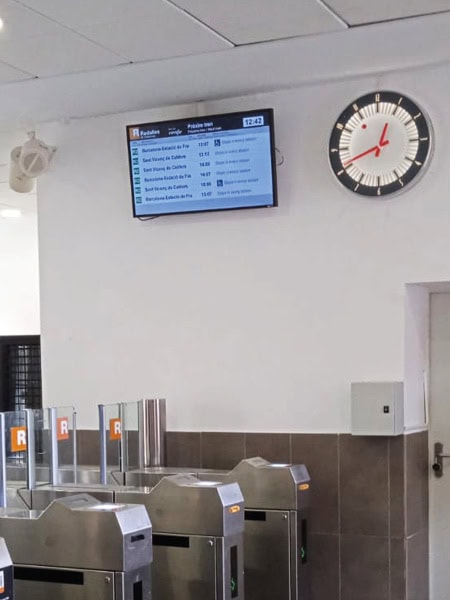Why did RENFE choose an NTP solution?

Who is RENFE?
RENFE (Red Nacional de los Ferrocarriles Españoles) refers to the National Network of Spanish Railways. It is the state-owned company responsible for operating passenger and freight train services in Spain. Established in 1941, RENFE manages the movement of trains on an extensive network of tracks that spans across the country, connecting major cities, regional areas, and international borders. The company plays a crucial role in the public transport sector in Spain, offering various types of train services, including long-distance, regional, suburban (Cercanías), and goods transportation. RENFE is known for its commitment to safety, punctuality, and customer service, making it an integral part of Spain's transportation infrastructure.
Revolutionizing Rail Transport with Advanced Time Technology
In rail transport, punctuality and reliability of services are of the utmost importance. Time technology plays a central role, particularly in the synchronization and coordination of train operations across extensive networks. The Spanish railway company RENFE has made a major technological leap by switching from older time protocols such as AFNOR or 24V Minute impulses to an NTP solution using the Ethernet network. NTP stands for Network Time Protocol. This modern and precise solution was installed in collaboration with MOBATIME and its Spanish subsidiary Tecnikronos.
The challenge of traditional timing systems
Although traditional older time protocols such as AFNOR or 24V Minute impulses provide basic time measurement, they reach their limits in modern rail transport systems. These systems can be affected by electrical disturbances and sometimes by environmental influences such as temperature fluctuations or vibrations, leading to inaccuracies in time measurement. Another problem is the absence of control. At no time the operator can be sure that the provided time has been received correctly which is not acceptable nowadays.
The transition to NTP - RENFE as a perfect example
Network Time Protocol, or short NTP, is a protocol for transmitting time via computer networks. It enables accurate time measurement by synchronizing clocks within a network to within a few milliseconds. In the context of rail transport, NTP enables central synchronization of all clocks in the network, leading to a significant improvement in operational reliability and safety.
Using the existing IT networks to distribute the time is much more simple than running kilometers of specific cabling dedicated to time distribution only. It allows not only to synchronize clocks but also any device in connection to the network.
But the major difference is the capacity of supervision which was not possible with the legacy systems. In the case of RENFE, the supervision capacity is even enhanced by the use of sensors and alarms cards inside the clocks to indicate a shock or low battery or low illumination level. Therefore, the operators are informed in real time when a system is failing, weak or vandalized and maintenance is more efficient since the teams know what has to be changed and technicians can bring the suitable component right on the first visit.
RENFE's decision in favor of NTP, implemented by MOBATIME and Tecnikronos, marks an important development in the integration of modern technologies into its infrastructure. This technology not only provides improved timekeeping accuracy, but also a more robust platform for the future on which further technological advances can be built.
Technical realisation and advantages
The technical implementation of NTP by MOBATIME and Tecnikronos involved the installation of NTP-enabled time servers and the creation of a network that synchronizes all clocks in RENFE's operation. These clocks are now able to receive the time information from the NTP server and automatically adjust themselves, ensuring accuracy across the network.
The advantages of this changeover are manifold:
✓ Progressivity:
RENFE has considered the deployment of NTP progressively by selecting master clocks capable of providing NTP as well as legacy protocols. In this way, RENFE can adapt the pace necessary to move fully to NTP.
✓ Increased accuracy and reliability:
With NTP, clock systems are less susceptible to drift and interference from environmental factors.
✓ Improved safety:
More accurate time measurement enables better control of the train stations and the railway activity since all servers and devices are using the same time base, which increases safety.
✓ More efficient operations management:
Accurate time measurement allows maintenance work to be better planned and delays to be minimized.
✓ Future-proof:
NTP provides a platform that can be easily updated and expanded with new technologies to keep pace with the changing needs of rail transport.

Renovation and recommissioning of a traditional clock
Modernity does not mean that traditions are forgotten!
This clock, which is displayed in a prominent position, dates back to a time when public clocks were not only functional but also aesthetic masterpieces. Its design, with its Roman numerals and clear dial structure, is reminiscent of an era in which precision and elegance went hand in hand. This clock was a central element of the cityscape and played an important role in people's daily lives.
The renovation of this clock was a painstaking process of preserving historical details while incorporating modern mechanisms. Our team has ensured that the clock is both visually appealing and technically reliable. The Roman numerals have been carefully restored and the movement has been modernized to ensure accurate timekeeping.






